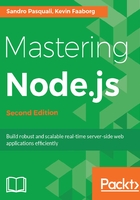
Flags
There are a number of settings available to you for manipulating the Node runtime. Try this command:
$ node -h
In addition to standards such as --version, you can also flag Node to --abort-on-uncaught-exception.
You can also list the options available for v8:
$ node --v8-options
Some of these settings can save the day. For example, if you are running Node in a restrained environment like a Raspberry Pi, you might want to limit the amount of memory a Node process can consume, to avoid memory spikes. In that case, you might want to set the --max_old_space_size (by default ~1.5GB) to a few hundred MB.
You can use the -e argument to execute a Node program as a string; in this case, logging out of the version of V8 your copy of Node contains:
$ node –e "console.log(process.versions.v8)"
It's worth your time to experiment with Node/V8 settings, both for their utility and the path, to give you a slightly stronger understanding of what is happening (or might happen) under the hood.